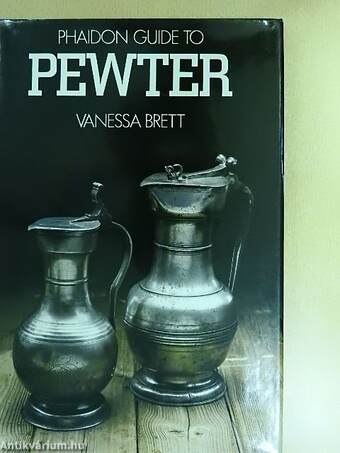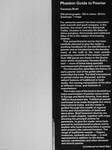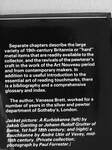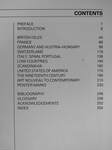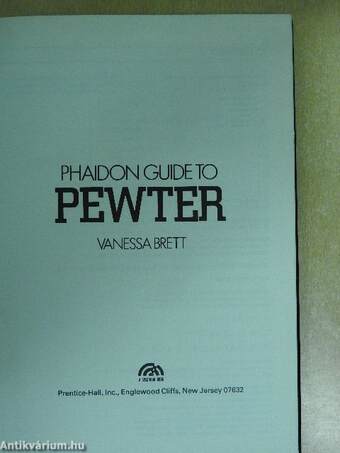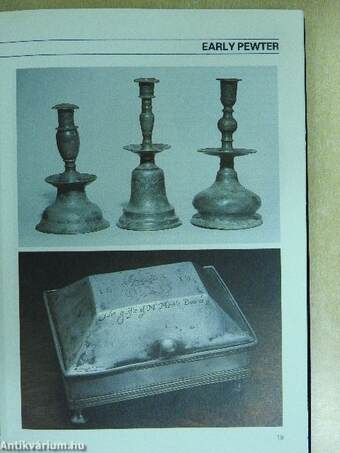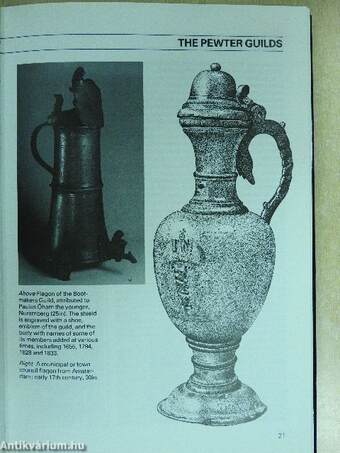1.067.327
kiadvánnyal nyújtjuk Magyarország legnagyobb antikvár könyv-kínálatát

VISSZA
A TETEJÉRE
JAVASLATOKÉszre-
vételek
Phaidon Guide to Pewter
| Kiadó: | Prentice-Hall, Inc. |
|---|---|
| Kiadás helye: | Englewood Cliffs |
| Kiadás éve: | |
| Kötés típusa: | Fűzött kemény papírkötés |
| Oldalszám: | 256 oldal |
| Sorozatcím: | Spectrum Books |
| Kötetszám: | |
| Nyelv: | Angol |
| Méret: | 23 cm x 16 cm |
| ISBN: | 0-13-662049-3 |
| Megjegyzés: | Színes és fekete-fehér fotókkal, illusztrációkkal. |
naponta értesítjük a beérkező friss
kiadványokról
naponta értesítjük a beérkező friss
kiadványokról
Fülszöveg
Phaidon Guideto Pewter
Vanessa Brett
250 photographs, 120 in colour; 80 line drawings; 7 maps
For centuries pewter has been associated with warmth and good company, in the kitchen, the tavern and the dining hall. Today, its place in everyday lifetaken by china and glass, this homely and traditional alloy of tin is the subject of increasing interest.
This comprehensive survey has been carefully planned to give the reader a working handbook for the Identification of pewter and an introduction to the develop-ment of the craft in the main pewter-producing countries of the western world. Over 500 pieces are shown in the illustra-tions which accompany Vanessa Brett's text — most of these being specially commissioned photographs and drawings.
The Introduction describes the history of early pewter and of the guilds which controlled the trade. The chief international or period styles are discussed, and the salient features of traditional or local styles, the varying composition of the... Tovább
Fülszöveg
Phaidon Guideto Pewter
Vanessa Brett
250 photographs, 120 in colour; 80 line drawings; 7 maps
For centuries pewter has been associated with warmth and good company, in the kitchen, the tavern and the dining hall. Today, its place in everyday lifetaken by china and glass, this homely and traditional alloy of tin is the subject of increasing interest.
This comprehensive survey has been carefully planned to give the reader a working handbook for the Identification of pewter and an introduction to the develop-ment of the craft in the main pewter-producing countries of the western world. Over 500 pieces are shown in the illustra-tions which accompany Vanessa Brett's text — most of these being specially commissioned photographs and drawings.
The Introduction describes the history of early pewter and of the guilds which controlled the trade. The chief international or period styles are discussed, and the salient features of traditional or local styles, the varying composition of the alloy at different times, and methods of manufacture.
The major part of the book is devoted to a close examination of pewter wares made in Europe and North America, from about 1600 to the present day. Traditional vessels continued to be made alongside the newer international styles, and the reader is guided through this wealth of régiónál forms and characteristics of detail and decoration. Brief historical résumés are given in each chapter, together with maps showing the principal centres for pewterers, to give the reader somé back-ground to commemorative pieces and to explain why local characteristics in pewter span present-day national frontiers. The rangé of traditional vessels — flagons, measures, tankards and mugs — is well represented in addition to the dishes, spoons, candlesticks and other domestic and church pewter.
(continued on back flap)
Separate chapters describe the large variety of 19th-century Britannia or "hard" metál items that are readily available to the collector, and the revivals of the pewterer's craft in the work of the Art Nouveau period and from contemporary makers. In addition to a useful introduction to the essential art of reading touchmarks, there is a bibliography and a comprehensive glossary and index.
The author, Vanessa Brett, worked for a number of years in the silver and pewter department of Sotheby's, London.
Jacketpicture: A Kurbiskanne (left) by Jákob Ganting or Johann Rudolf Grutter of Beme, Ist half 18th century; and (right) a Bauchkanne by André Utin of Vevey, mid-18th century. (Priváté collection; photograph by Paul Forrester.) Vissza



